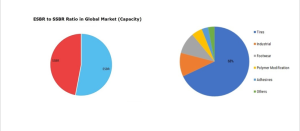STYRENE-BUTADIENE RUBBER (SBR) , is undoubtedly the most widespread synthetic rubber in the world. Butadiene (CH2 = CH-CH = CH2) and styrene (C6H5-CH = CH2) are the basic monomers for the production of SBR, with the styrene content being around 23.5%, with SBR grades having a styrene content of 40 to 85%. As the styrene content increases, the polymerization product (SBR) assumes more the characteristic of thermoplastic product, so this type is always used combined with normal SBR, thus obtaining greater ease of work. Most of the SBR, about 85 to 90%, is polymerized by emulsion, with the remaining 10 to 15% being polymerized in solution. Depending on the polymerization temperature, the rubber obtained is classified as “hot rubber” if the polymerization temperature is about 55 ° C and “cold rubber” if the polymerization temperature is between 5-10 ° C.
SBR has good abrasion resistance and good aging stability when protected by additives. About 50% of car tires are made from various types of SBR. The styrene/butadiene ratio influences the properties of the polymer: with high styrene content, the rubbers are harder and less rubbery.
Key benefits of SBR include:
- Abrasion resistance
- Perfect impact strength
- Good resilience
- High tensile strength

SBR Types :
There are two major types of SBR with different properties based on their manufacturing process:
- Emulsion SBR (e-SBR) – Hot SBR or Cold SBR
- Solution SBR (s-SBR)
Emulsion SBR (e-SBR)
It can be produced by free-radical emulsion polymerization of styrene and butadiene either at 50 to 60°C (hot emulsion SBR) or at about 5°C (cold emulsion SBR).
- The hot emulsion SBR process, which was developed first, leads to a more branched polymer than the cold emulsion process. SBR grades produced using this process have exception processing characteristics such as low mill shrinkage, good dimensional stability, and good extrusion characteristics
- On the other hand,Cold SBR has a better abrasion resistance and, consequently, provides better tread wear and dynamic properties. It also exhibits superior mechanical properties such as tensile strength compared to grades produced by the hot emulsion polymerization route
Key Features
- Green strength becomes low with increasing oil extension
- Low resilience and low tensile strength
- Outstanding resistance to abrasion
- Low resistance to oil, other hydrocarbon fluids and ozone
- Hot polymers are difficult to process with low green strength
- Poor tear strength
- High styrene resins have good low-temperature properties but stiffen

Solution SBR (s-SBR)
Solution SBR is produced , anionic solution polymerization of styrene and butadiene with alkyl lithium initiator in a hydrocarbon solvent, usually hexane or cyclohexane.
S-SBR grades have improved flexibility, performance, superior mechanical properties like tensile strength, low rolling resistance etc. especially when used in tires.
Solution SBR has a narrower molecular weight distribution, higher molecular weight, and higher cis-1,4-polybutadiene content than emulsion polymerization SBR.
Key Features:
- Good resilience and tensile strength
- Outstanding resistance to abrasion and fatigue
- Low resistance to oil, other hydrocarbon fluids and ozone
SBR properties
- Excellent mechanical properties, moderate to tear
- Price cheaper than the natural cacuho
- Lower resilience compared to natural rubber
- Good resistance to aging and temperature
- Temperature range: between -50ºC and 90ºC
- Good chemical resistance to many inorganic chemicals, but bad with oxidizing acids
- Resistance limited to mineral acids, not being suitable for organic liquids in general
- Its resistance can be increased with a suitable formulation
SBR Classification
According to the code of the International Institute of Synthetic Rubber Producers (SIS), the SBR copolymers are classified into different categories:
SBR 1000 series: Copolymers obtained by hot copolymerization.
SBR 1500 series: Copolymers obtained by cold copolymerization. Its properties depend on the reaction temperature and the content of styrene and emulsifier. The variation of these parameters affects the molecular weight and therefore the properties of the vulcanized mixture.
SBR 1700 series: SBR 1500 extended with oil.
SBR series 1600 and 1800: Carbon black is mixed with SBR 1500 rubber during production by incorporating an aqueous dispersion of carbon black with the SBR latex previously spread with oil. A master mix is obtained close to the final product after coagulation and drying.
Gamma Development Co. offers the most completive prices for this product. For receiving a quote please sends us your inquiry along with the LOI to our email :
export (@) gamma-co (.) ir
